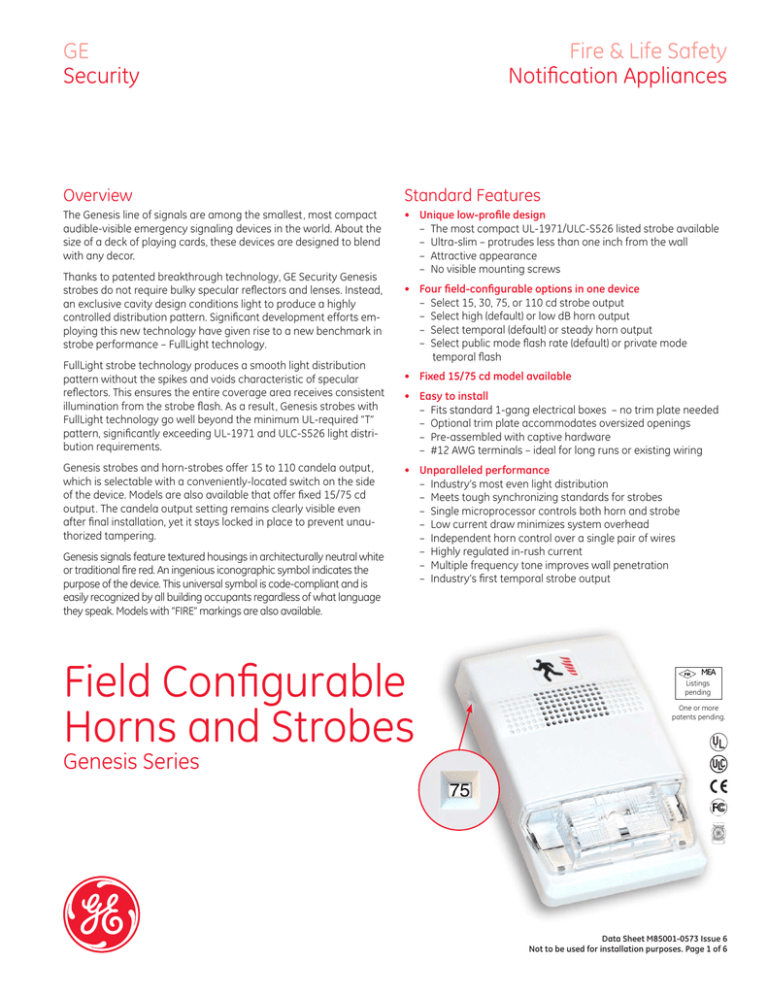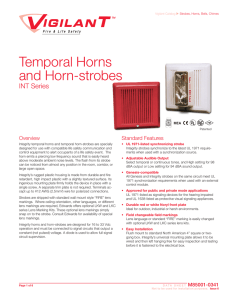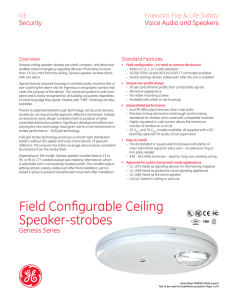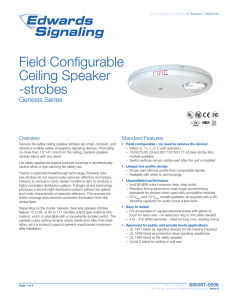
GE
Security
Fire & Life Safety
Notification Appliances
Overview
Standard Features
The Genesis line of signals are among the smallest, most compact
audible-visible emergency signaling devices in the world. About the
size of a deck of playing cards, these devices are designed to blend
with any decor.
• Unique low-profile design
– The most compact UL-1971/ULC-S526 listed strobe available
– Ultra-slim – protrudes less than one inch from the wall
– Attractive appearance
– No visible mounting screws
Thanks to patented breakthrough technology, GE Security Genesis
strobes do not require bulky specular reflectors and lenses. Instead,
an exclusive cavity design conditions light to produce a highly
controlled distribution pattern. Significant development efforts employing this new technology have given rise to a new benchmark in
strobe performance – FullLight technology.
FullLight strobe technology produces a smooth light distribution
pattern without the spikes and voids characteristic of specular
reflectors. This ensures the entire coverage area receives consistent
illumination from the strobe flash. As a result, Genesis strobes with
FullLight technology go well beyond the minimum UL-required “T”
pattern, significantly exceeding UL-1971 and ULC-S526 light distribution requirements.
Genesis strobes and horn-strobes offer 15 to 110 candela output,
which is selectable with a conveniently-located switch on the side
of the device. Models are also available that offer fixed 15/75 cd
output. The candela output setting remains clearly visible even
after final installation, yet it stays locked in place to prevent unauthorized tampering.
Genesis signals feature textured housings in architecturally neutral white
or traditional fire red. An ingenious iconographic symbol indicates the
purpose of the device. This universal symbol is code-compliant and is
easily recognized by all building occupants regardless of what language
they speak. Models with “FIRE” markings are also available.
• Four field-configurable options in one device
– Select 15, 30, 75, or 110 cd strobe output
– Select high (default) or low dB horn output
– Select temporal (default) or steady horn output
– Select public mode flash rate (default) or private mode
temporal flash
• Fixed 15/75 cd model available
• Easy to install
– Fits standard 1-gang electrical boxes – no trim plate needed
– Optional trim plate accommodates oversized openings
– Pre-assembled with captive hardware
– #12 AWG terminals – ideal for long runs or existing wiring
• Unparalleled performance
– Industry’s most even light distribution
– Meets tough synchronizing standards for strobes
– Single microprocessor controls both horn and strobe
– Low current draw minimizes system overhead
– Independent horn control over a single pair of wires
– Highly regulated in-rush current
– Multiple frequency tone improves wall penetration
– Industry’s first temporal strobe output
Field Configurable
Horns and Strobes
MEA
Listings
pending
One or more
patents pending.
Genesis Series
Data Sheet M85001-0573 Issue 6
Not to be used for installation purposes. Page of 6
Application
Genesis strobes are UL 1971-listed for use indoors as wall-mounted
public-mode notification appliances for the hearing impaired.
Prevailing codes require strobes to be used where ambient noise
conditions exceed 105 dBA (87dBA in Canada), where occupants
use hearing protection, and in areas of public accommodation as
defined in the Americans with Disabilities Act (see application notes
– USA).
Combination horn-strobe signals must be installed in accordance
with guidelines established for strobe devices.
Strobes
Although all Genesis strobes are self-synchronizing, when installed
with an optional synchronization module, strobe flashes from
devices on the same circuit synchronize to within 10 milliseconds
of each other indefinitely. This exceeds the two-hour minimum
specified in the UL standards. Only one synchronization module is
required per circuit.
The following guidelines are based on ANSI/NFPA 72 National Fire
Alarm Code (1999). When applied and installed in accordance with
that code, GE Security strobes meet or exceed the illumination produced by the ADA-specified 75 candela (cd) strobe at 50 feet.*
Non-Sleeping Rooms and Corridors: GE Security strobes rated at
less than 110 cd per UL 1971 are intended for use in non-sleeping
areas only. Install with the bottom of the device at least 80 inches
(2.0 m) and no more than 96 inches (2.4 m) above the finished floor.
No point in any space (including corridors) required to have strobes
should be more than 50 feet (15.2 m) from the signal (in the horizontal plane).
Non-Sleeping Rooms
Up to 20’ x 20’ (6.1 x 6.1m)
Up to 30’ x 30’ (9.1 x 9.1m)
Up to 40’ x 40’ (12.2 m x 12.2 m)
Up to 50’ x 50’ (15.2 x 15.2m)
Use One Wall Mounted Model:
One 15 cd strobe
One 30 cd or two 15 cd strobes
One 75 cd or two 30 cd strobes
One 110 cd or two 75 cd strobes
Corridors
Wall Mounted - Model:
15 cd strobes spaced at 100’ (30.5 m)
max. Strobes must be placed within
15’ (4.5m) of each end of the corridor.
Any Length x Max. 20’
(6.1m) Wide
* ADA suggests using 75 cd strobes throughout an area, with spacing that never
exceeds 50 ft from the strobe to any point in the protected space.
Sleeping rooms: GE Security 110 cd strobes are intended for use in
sleeping rooms and should be installed along with a smoke detector. It must be wall mounted at least 80” (2.03 m) above floor level,
but no closer than 24” (610 mm) to the ceiling. The distance from
the strobe to the pillow must not exceed 16’ (4.8 m).
Sleeping Rooms
Any Size
Use One Wall Mounted Model:
110 cd within 16 feet of pillow
For 177 cd ceiling horn-strobes, please refer to Data Sheet M85001-0559.
Horns
Genesis horn output reaches as high as 99 dB and features a
unique multiple frequency tone that results in excellent wall penetration and an unmistakable warning of danger. Horns may be
configured for either coded or non-coded signal circuits. They can
also be set for low dB output with a jumper cut that reduces horn
output by about 5 dB.
The suggested sound pressure level for each signaling zone used with
alert or alarm signals is at least 15 dB above the average ambient sound
level, or 5 dB above the maximum sound level having a duration of at
least 60 seconds, whichever is greater, measured 5 feet (1.5 m) above the
floor. The average ambient sound level is, A-weighted sound pressure
measured over a 24-hour period.
Doubling the distance from the signal to the ear will theoretically result
in a 6 dB reduction of the received sound pressure level. The actual effect depends on the acoustic properties of materials in the space. A 3
dBA difference represents a barely noticeable change in volume.
Application Notes - USA
Audible signals in the public mode should never have a sound level
less than 75 dBA at 10’ (3 m) per NFPA 72. Signals cannot exceed
120 dBA per ADA and NFPA 72 at the minimum hearing distance to
audible appliance.
Strobe and combination horn/strobe devices should be installed
with the bottom of the device at least 80 inches (2.0 m) and no more
than 96 inches (2.4 m) above the finished floor. Horns should be
installed with their tops not less than 6 inches (152 mm) below the
ceiling and not less than 90 inches (2.3 m) above the finished floor.
Strobes must be used to supplement audible signals wherever
the average ambient sound level exceeds 105 dBA. Combination
audible/visual signals must be installed in accordance with NFPA
guidelines established for strobes.
ADA requires visible signals in the following areas:
• rest rooms, meeting rooms, and other common use areas.
• sleeping rooms intended for use by persons with hearing impairment (in accordance with Title 1 of ADA).
• work areas used by a person with a hearing impairment (per Title
1 of ADA).
Application Notes - Canada
(Based in part on 1995 Canada National Building Code)
The fire alarm signal sound pressure level shall not exceed 110 dBA
in any normally occupied area. The sound pressure level from
an audible signal in a floor area used for occupancies other than
residential occupancies shall not be less than 10 dBA above ambient levels, and never less than 65 dBA. In sleeping rooms the sound
pressure level from an audible signal shall not be less than 75 dBA
when any intervening doors between the device and the sleeping
room are closed. Audible signal devices shall be installed not less
than 1.8 m to the center of the device above the floor (per CAN/ULC
S524).
The fire alarm audible signal shall be supplemented by fire alarm
strobes in any floor area where the ambient noise level exceeds 87
dBA, or where the occupants of the floor area use ear protective
devices, are located within an audiometric booth, or are located
within sound insulating enclosures. This also applies to assembly
occupancies in which music and other sounds associated with
performances could exceed 100 dBA
Strobes shall be installed in a building so that the flash from one device is visible throughout the floor area or portion thereof in which
they are installed. For maximum safety, GE Security recommends
that strobes be installed as per the guidelines shown here under
Strobe Spacing.
Data Sheet M85001-0573 Issue 6
Not to be used for installation purposes. Page of 6
Installation
Genesis horns and strobes mount to any standard one-gang surface or flush electrical box. Matching optional trim plates are used
to cover oversized openings and can accommodate one-gang,
two-gang, four-inch square, or octagonal boxes, and European 100
mm square.
All Genesis signals come pre-assembled
with captive mounting screws for easy installation. Two tabs at the top of the signal
unlock the cover to reveal the mounting
hardware. The shallow depth of Genesis
devices leaves ample room behind the
signal for extra wiring. Once installed with
the cover in place, no mounting screws are
visible.
Field Configuration
Genesis Horn/Strobe
with optional trim plate
Temporal horn and horn-strobe models
are factory set to sound in a three-pulse
temporal pattern. Units may be config-
Wiring
Field wiring terminals accommodate #18 to #12 AWG (0.75 mm² to
2.5 mm²) wiring. Horns, strobes, and combination horn-strobes are
interconnected with a single pair of wires as shown below.
+
+
Polarity shown in
alarm condition
ured for use with coded systems by cutting a jumper on the circuit
board. This results in a steady output that can be turned on and off
(coded) as the system applies and removes power to the signal circuit. A Genesis Signal Master is required when horn-strobe models
are configured for coded systems. Non-temporal, horn-only models
sound a steady tone.
Genesis strobes and horn-strobes are shipped from the factory ready for use as UL 1971 compliant signals for public mode
operation. These signals may be configured for temporal flash by
cutting a jumper on the circuit board. This battery-saving feature is
intended for private mode signaling only.
Genesis strobes and horn-strobes may be set for 15, 30, 75, or 110
candela output. The output setting is changed by simply opening
the device and sliding the switch to the desired setting. The device
does not have to be removed to change the output setting. The
setting remains visible through a small window on the side of the
device after the cover is closed.
Horns and horn-strobes are factory set for high dB output.
Low dB output may be selected by cutting a jumper on the circuit
board. This reduces the output by about 5 dB.
WARNING: These devices will not operate without electrical power. As fires frequently
cause power interruptions, we suggest you discuss further safeguards with your local
fire protection specialist.
These visual signal appliances’ flash intensity may not be adequate to alert or waken
occupants in the protected area. Research indicates that the intensity of strobe needed
to awaken 90% of sleeping persons is approximately 100 cd. GE Security recommends
that strobes in sleeping rooms be 110 cd minimum.
+
H
H
-
-
To next device
or end of line
device
Note: Strobes must have continuous voltage.
Data Sheet M85001-0573 Issue 6
Not to be used for installation purposes. Page of 6
Current Draw
Strobes, Horn-Strobes
Horns
Multi-cd Wall Strobes (MG1-VM)
Wall Temporal Horns (MG1-HD)
15 cd*
30 cd*
15/75 cd**
RMS
RMS
RMS
16 Vdc
103
141
106
16 Vfwr
125
179
170
*MG1-VM multi-cd; **MG1F-V1575 fixed 15/75 cd
UL
Rating
Typical
Current
16 Vdc
20 Vdc
24 Vdc
33 Vdc
16 Vfwr
20 Vfwr
24 Vfwr
33 Vfwr
15 cd
RMS Mean
85
79
71
66
59
55
46
44
119
64
103
51
94
44
87
37
30 cd
RMS Mean
127
124
98
96
82
80
64
63
169
97
143
76
129
65
112
52
15/75
RMS Mean
150
140
123
114
104
97
84
77
223
126
189
100
169
85
148
68
75 cd*
RMS
255
346
110 cd*
RMS
311
392
75 cd
RMS Mean
245
243
188
186
152
150
112
111
332
203
253
150
218
121
179
89
110 cd
RMS Mean
285
283
240
238
191
190
137
136
376
240
331
198
262
152
205
106
Wall Temporal Horn-strobes – High dB Setting
UL
Rating
16 Vdc
16 Vfwr
Typical
Current
16 Vdc
20 Vdc
24 Vdc
33 Vdc
16 Vfwr
20 Vfwr
24 Vfwr
33 Vfwr
15
cd*
RMS
129
176
30
cd*
RMS
167
230
15 cd
RMS Mean
102
89
88
77
81
71
74
64
144
77
141
68
136
65
125
54
75
cd*
RMS
281
397
110
cd*
RMS
337
443
30 cd
RMS Mean
135
129
109
104
94
90
72
74
182
106
162
87
152
76
144
65
15/75
cd**
RMS
172
269
*MG1-HDVM multi-cd
**MG1F-HDV1575 fixed 15/75 cd
16 Vdc
16 Vfwr
Typical
Current
16 Vdc
20 Vdc
24 Vdc
33 Vdc
16 Vfwr
20 Vfwr
24 Vfwr
33 Vfwr
15
cd*
RMS
122
162
30
cd*
RMS
160
216
15 cd
RMS Mean
96
84
79
70
68
61
56
52
128
69
118
60
113
54
112
48
75
cd*
RMS
274
383
110
cd*
RMS
330
429
15/75
RMS Mean
160
152
137
129
122
114
106
98
247
143
220
120
203
106
196
94
30 cd
RMS Mean
130
124
104
99
88
84
71
68
180
104
157
84
144
74
137
64
15/75
cd**
RMS
146
231
Typical
Current
16 Vdc
20 Vdc
24 Vdc
33 Vdc
16 Vfwr
20 Vfwr
24 Vfwr
33 Vfwr
High dB (RMS)
Low dB (RMS)
26
36
41
51
69
76
19
27
33
37
52
70
High dB
RMS
Mean
22
17
24
19
27
21
32
25
34
15
40
19
45
21
52
24
75 cd
RMS Mean
246
242
193
190
161
158
124
121
352
212
274
158
235
133
201
101
110 cd
RMS Mean
309
305
248
243
203
200
154
151
393
249
362
210
282
165
232
123
RMS
17
19
22
26
30
34
38
47
Low dB
Mean
14
16
18
22
14
16
18
22
Wall Horns (MG1-P)
UL Designation
Regulated 24 Vdc
24 fwr
Typical Current
24 Vdc
24 Vdc
31 Vdc
20 Vfwr
24 Vfwr
16 - 33 Vdc
16 - 33 Vfwr
Max. Current,
RMS
13 mA
11 mA
RMS
10
11
12
9
10
Mean
10
11
12
8
9
Voltage Range
Notes and Comments
1. Current values are shown in mA.
2. UL Nameplate Rating can vary from Typical Current due to
measurement methods and instruments used.
Wall Temporal Horn-strobes – Low dB Setting
UL
Rating
UL
Rating
16 Vdc
24 Vdc
33 Vdc
16 Vfwr
24 Vfwr
33 Vfwr
3. GE Security recommends using the Typical Current for system
design including NAC and Power Supply loading and voltage
drop calculations.
*MG1-HDVM multi-cd
**MG1F-HDV1575 fixed 15/75 cd
15/75
RMS Mean
158
149
133
124
119
110
100
93
241
139
213
115
195
101
182
87
75 cd
RMS Mean
243
240
189
186
156
154
118
116
344
204
266
156
230
128
197
99
110 cd
RMS Mean
302
297
241
237
197
193
146
143
389
244
343
200
279
161
226
117
4. Use the Vdc RMS current ratings for filtered power supply and
battery AH calculations. Use the Vfwr RMS current ratings for
unfiltered power supply calculations.
5. Fuses, circuit breakers and other overcurrent protection devices
are typically rated for current in RMS values. Most of these
devices operate based upon the heating affect of the current
flowing through the device. The RMS current (not the mean current) determines the heating affect and therefore, the trip and
hold threshold for those devices.
6. Our industry has used ‘mean’ currents over the years. However,
UL will direct the industry to use the 2004 RMS values in the
future.
Data Sheet M85001-0573 Issue 6
Not to be used for installation purposes. Page of 6
dBA output
Average Sound Output (dBA)
(High dB setting, anechoic, 24V, measured at 10ft)
Temporal Horns, Horn-strobes (MG1-HD, MG1-HDVM series)
UL464
High dB
Setting
Temporal
Steady
16 Vdc
24 Vdc
33 Vdc
81.4
84.4
86.3
85.5
88.6
90.4
UL464
Low dB
Setting
Temporal
Steady
16 Vdc
24 Vdc
33 Vdc
76.0
79.4
82.1
80.1
83.5
86.5
Average
Temporal/
Steady
91.4
94.5
96.9
Peak
Temporal/
Steady
94.2
97.6
99.5
Average
Temporal/
Steady
86.3
89.8
92.5
Peak
Temporal/
Steady
89.2
92.5
95.3
-90°
120 110 100 90
80
70
60
50
40
30
20
10
dBA
0 10
20
30
40
50
60
70
80
90 100 110 120
-75°
90°
75°
60°
-60°
45°
-45°
30°
-30°
-15°
15°
0°
Light output - (effective cd)
Percent of UL rating versus angle
Steady Tone Horns (MG1-P series)
16 Vdc
16 Vfwr
UL464
77 dBA, min
77 dBA, min
Average
85 dBA
85 dBA
Notes
Peak
91 dBA
91 dBA
120 110 100 90
80
70
60
50
40
30
Per Cent of UL Rating
20 10 0 10 20
30
40
50
60
70
80
90 100 110 120
-75°
90°
75°
1. All values shown are dBA measured at 10 feet (3.01m).
2. UL464 values measured in reverberation room.
-60°
60°
3. Average and Peak values are measured in anechoic chamber.
-45°
45°
-30°
30°
-15°
0°
15°
Specifications
Housing
Lens
Mounting
(indoor wall mount only)
Wire connections
Operating environment
Agency listings/approvals
Dimensions (HxWxD)
Operating voltage
Strobe output rating
Strobe flash rate
Compatible synchronization
modules*
Horn pulse rate
Temporal audible pattern
Red or white textured UV stabilized, color impregnated engineered plastic. Exceeds 94V-0 UL flammability rating.
Optical grade polycarbonate (clear)
Flush mount: 2½ inch (64 mm) deep one-gang box
Surface mount: Model 27193 surface mount box, wiremold box, or equivalent surface-mount box
With optional trim plate: One-gang, two-gang, four-inch square, octagonal, or European single-gang box
Screw terminals: single input for both horn and strobe. #18 to #12 AWG (0.75 mm² to 2.5 mm²) wire size
Indoor only: 32-120°F (0-49°C) ambient temperature. 93% relative humidity
UL 1971, UL 1638, UL 464, ULC S525, ULC S526, CSFM, CE, FCC, (MEA, FM pending).
(All models comply with ADA Code of Federal Regulation Chapter 28 Part 36 Final Rule.)
Signal: 4-1/2” x 2-3/4” x 13/16” (113 mm x 68 mm x 21 mm)
Trimplate: 5” (127 mm); Height – 5-7/8” (149 mm); Depth – ½” (13 mm)
MG1-HD series temporal-tone horns: non-coded, filtered 16-33 Vdc or unfiltered 16-33 Vdc FWR (or coded when horn set to
steady tone)
MG1-HDVM series temporal-tone horn-strobes: non-coded, filtered 16-33 Vdc or unfiltered 16-33 Vdc FWR (or coded
(audible NAC only) when used with optional MG1M Genesis Signal Master)
MG1-VM series strobes: non-coded, filtered 16 - 33 Vdc or unfiltered 16-33 Vdc FWR
MG1-P series steady-tone horns: coded or non-coded, filtered 20-31 Vdc or unfiltered 20-27 Vfwr
UL 1971, UL 1638, ULC S526: selectable 15 cd, 30 cd, 75 cd, or 110 cd output
UL 1971: 15 cd (fixed 15/75 cd models)
UL 1638, ULCS526: 75 cd (fixed 15/75 cd models)
MG1-VM strobes and MG1-HDVM series temporal-tone horn-strobes: one flash per second synchronized with optional
MG1M Genesis Signal Master indefinitely within 10 milliseconds (or self-synchronized within 200 milliseconds over thirty
minutes on a common circuit without MG1M Genesis Signal Master) Temporal setting (private mode only): synchronized to
temporal output of horns on same circuit
MG1M, MG1M-RM
MG1-HD temporal-tone horns and MG1-HDVM series temporal-tone horn-strobes: temporal rate synchronized with
optional MG1M Genesis Signal Master indefinitely within 10 milliseconds (or self-synchronized within 200 milliseconds over
thirty minutes on a common circuit without MG1M Genesis Signal Master) MG1-P steady-tone horns: continuous, steady
tone only
½ sec ON, ½ sec OFF, ½ sec ON, ½ sec OFF, ½ sec ON, 1½ sec OFF, then repeat cycle
* Not compatible with MG1-P Series horns.
Data Sheet M85001-0573 Issue 6
Not to be used for installation purposes. Page of 6
GE
Security
U.S.
T 888-244-9979
F 866-503-3996
Canada
T 519 376 2430
F 519 376 7258
Asia
T 852 2907 8108
F 852 2142 5063
Australia
T 61 3 9259 4700
F 61 3 9259 4799
Europe
T 32 2 725 11 20
F 32 2 721 86 13
Latin America
T 305 593 4301
F 305 593 4300
www.gesecurity.com
© 2006 General Electric Company
All Rights Reserved
Genesis Series is a Trademark
of GE Security.
Ordering Information
Catalog Number
White
Red
Finish
Finish
MG1MG1RHDVM
HDVM
MG1-VM
MG1R-VM
MG1-HD
MG1R-HD
MG1-P
MG1R-P
MG1FHDVM
MG1RFHDVM
MG1RFVM
MG1RFHD
MG1F-VM
MG1F-HD
MG1F-P
MG1RF-P
MG1FHDV1575
MG1FV1575
MG1RFHDV1575
MG1RFV1575
Mounting Accessories
MG1T
MG1RT
MG1TMG1RTFIRE
FIRE
27193-16 27193-11
Ship Wt.
lbs (kg)
Description
Genesis Horn-Strobe (selectable 15, 30, 75, or 110 cd output,
selectable high/low dB output)
Genesis Strobe (selectable 15, 30, 75, or 110 cd output)
Genesis Temporal Horn (selectable high/low dB output)
Genesis Steady Horn
(not compatible with Genesis Signal Master)
Genesis Horn-Strobe (selectable 15, 30, 75, or 110 cd output,
selectable high/low dB output) – with “FIRE” marking
Genesis Strobe (selectable 15, 30, 75, or 110 cd output)
– with “FIRE” marking
Genesis Temporal Horn (selectable high/low dB output)
– with “FIRE” marking
Genesis Steady Horn with “FIRE” marking
(not compatible with Genesis Signal Master)
15/75 cd temporal horn-strobe, hi/lo dB-24V
– with “FIRE” marking (see note 1)
0.25
(0.11)
15/75 cd strobe – with “FIRE” marking (see note 1)
Genesis Trim Plate (for two-gang or 4” square boxes)
Genesis Trim Plate (for two-gang or 4” square boxes)
with “FIRE” markings
One-gang surface mount box
Synchronization Modules
MG1M
Genesis Signal Master – Snap-on Mount
MG1M-RM
Genesis Signal Master – Remote Mount (1-gang)
0.15 (0.7)
0.15 (0.7)
1 (0.4)
0.2 (0.1)
Note 1: These 15/75 cd models provide fixed output and are not multi-candela devices. The 15 cd output component complies with UL1971, while the 75 cd output component complies with UL 1638.
Genesis Horn-Strobes may be ordered in red
or white, with or without ‘FIRE’ marking. Order
matching trim plates separately.
Data Sheet M85001-0573 Issue 6
Not to be used for installation purposes. Page of 6





